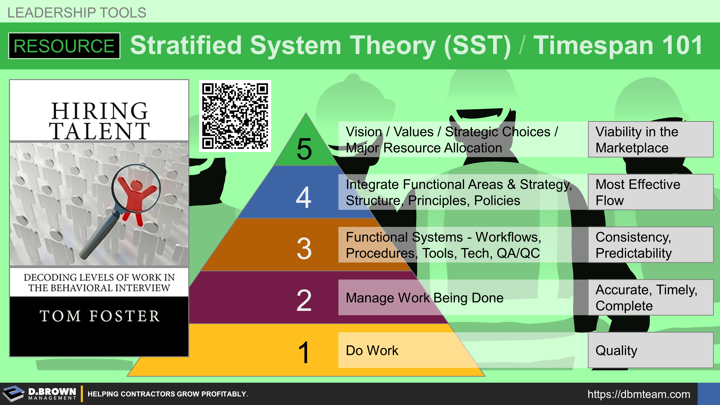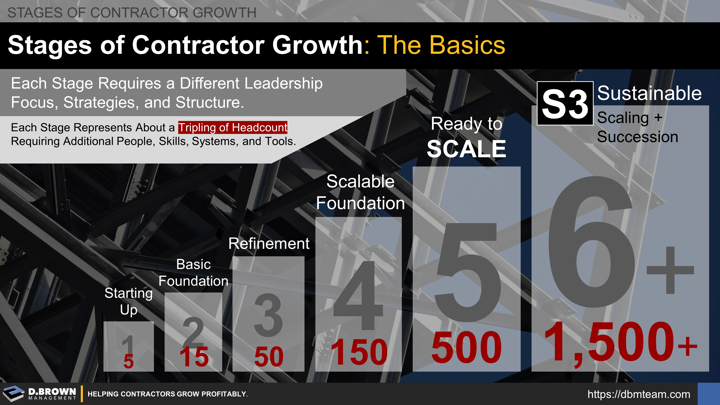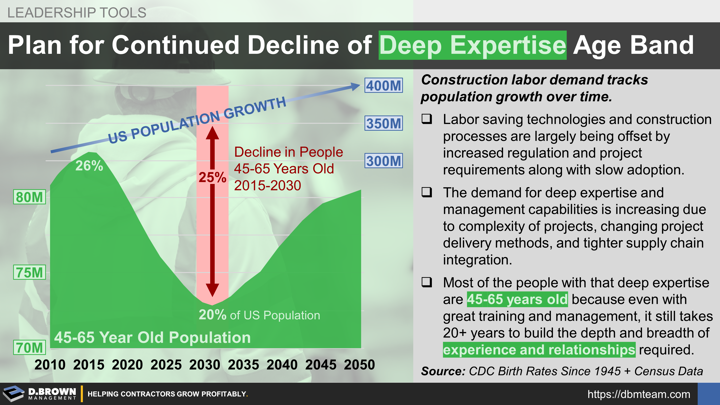WARNING: There are multiple dimensions to talent and no single model or tool will define everything about an individual's motivations, aptitudes, capabilities, or behaviors. They will not perfectly predict how someone will integrate with a team or perform in a role.
With the disclaimer out of the way, many of these models and tools are extremely valuable for helping contractors develop effective organizations for both the size they are at and to prepare for their next stages of growth. Tom Foster has done an amazing job integrating and building upon bodies of knowledge from Elliott Jaques on Stratified Systems Theory (SST) and Ichak Adizes on Corporate Lifecycles.
He has made these more complex theories easy to understand and apply to a construction business with a training program called Timespan 101 and book called Hiring Talent: Decoding Levels of Work in the Behavioral Interview.
For any contractor navigating towards Stage 3 with 50+/- employees and starting to define functional areas like project management, estimating, field operations, and accounting, this book and series of videos below is highly recommended.
Tom Foster believes in sharing knowledge broadly and freely to help improve businesses of all levels. Beyond his books or working with him directly, the key resources that we have found very helpful are:
- Timespan 101 Workbook and Training
- Management Myths and Timespan (2/12/2021 Video 3 Hours)
- Timespan 101 Playlist in 24 Parts (2.5 Hours Total)
The Timespan 101 Playlist is one of our most shared and used resources when it comes to helping contractors develop their organizations for long-term sustainability.
We recommend watching this multiple times with a notepad and your org chart in hand. Individual video links below:
- Time Span 101 (1:33 Minutes)
- Corporate Lifecycles (7:29 Minutes)
- Who the Hell is Elliott Jaques? (3:00 Minutes)
- Organizational Structure - Basic Building Block (4:43 Minutes)
- Learning Styles (3:45 Minutes)
- Problem Solving (5:07 Minutes)
- Levels of Work - Value Add (4:34 Minutes)
- Internal Silos and Stratum IV (4:59 Minutes)
- Elliott's Conundrum - The Discovery of Time Span (8:12 Minutes)
- Target Completion Time (6:27 Minutes)
- Calibrating Levels of Work (3:25 Minutes)
- States of Thinking and Boolean Logic (8:39 Minutes)
- Levels of Work and Population Statistics (4:09 Minutes)
- Potential Progression Chart (7:04 Minutes)
- Maximum Capability vs. Applied Capability (3:24 Minutes)
- Hiring Talent - Four Absolutes (9:33 Minutes)
- Behavioral Symptoms Caused by Mismatching Levels of Work (3:00 Minutes)
- Ranking Exercise (5:31 Minutes)
- Identifying Applied Capability (16:16 Minutes)
- Role of the Manager (11:25 Minutes)
- Hiring Talent - The Players (5:57 Minutes)
- Interview Questions to Identify Applied Capability (11:49 Minutes)
- Identifying Levels of Work in the Role Description (7:26 Minutes)
- Management Myths (2:29 Minutes)
The Leadership Pipeline (Related Body of Knowledge)
After making some notes about your team relate to Stratified Systems Theory (SST), take a brief look at the Leadership Pipeline Institute (LPI) model in the 8-minute intro video below. You will see heavy correlations with the value-add of each level of management in the organization.
Please contact us for a summary worksheet of both SST and LPI.
As you go through these videos, pay special attention to the ages of your key management team members, the age statistics and potential progression chart (#13/14 above), and the condition of the talent demographics in the US for contractors.
Please also think about your organizational structures and how they can set you up for succession, scalability, and sustainability.
We have helped contractors across the United States integrate their Talent Value Stream (TVS) with the strategy, business plans, and operations to help mitigate these demographic changes. Please contact us to learn more.



